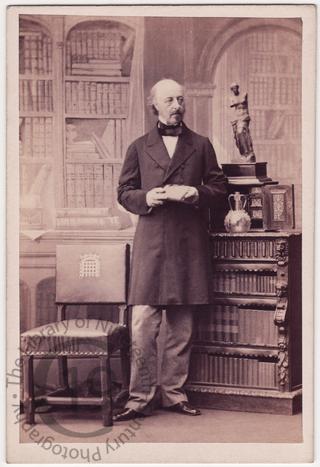
Robert Holford M.P.
A carte-de-visite portrait of the Member of Parliament Robert Holford (1808-1892).
Robert Stayner Holford was a wealthy landowner and art collector. His ancestors had already been rich for generations long before their involvement with the New River Company, which piped clean drinking water into London, added greatly to their fortunes. Robert personally inherited over a million pounds when his uncle died in 1838.
In 1829 he started what was eventually to become the Westonbirt Arboretum, near Tetbury in Gloucestershire. He also bought the freehold to some of the most expensive land in London, and built a new Dorchester House on Park Lane, a Renaissance palace completed in the 1870s. The building was demolished in 1929 to make way for the Dorchester Hotel.
On 5 August 1854 he married Mary Ann, youngest daughter of Major-General James Lindsay of Balcarras in the county of Fife.
From 1854 to 1872 he was the Member of Parliament for the Eastern division of the county of Gloucestershire.
Robert Stayner Holford died on 22 February 1892 at Dorchester House, Park Lane, leaving an estate valued at £422,432. Surprisingly for such a successful man, no obituary for him appeared in the Times, but nuggets of information about him can be gleaned from his son’s obituary, which appeared when George Holford died in 1926. ‘The estate to which Holford succeeded on the death of his father in 1892 was about 16,400 acres. It included the two houses which had been beautified and filled with lovely and interesting things by a great zeal and a fine taste. These qualities the son inherited; but with increasing taxation and other burdens he found it a difficult matter to keep up two such places as Dorchester House and Westonbirt. The London house he sometimes leased, notably to the Hon. Whitelaw Reid when United States ambassador, who was said to have paid a rental of 4,500 guineas a year.’ A later paragraph turns to the subject of Robert Holford’s vast collection of art and priceless manuscripts. ‘Sir George Holford was not a collector in the usual sense of the word, but he inherited from his father a noble collection of old masters and literary treasures of various kinds.’ The collection included, apparently, five Rembrandts, of which one was a self-portrait, four Van Dycks, again including a self-portrait, Velasquez’s full-length portrait of the Duke of Olivares, and Thomas Lawrence’s portrait of Lord Castlreagh. Among the manuscripts and incunabula were three works printed by Caxton, a first edition of Bunyan’s Pilgrim’s Progress ‘long thought to be the only perfect copy in existence,’ the first edition of Walton’s Angler and the First Folio Shakespeare, one of the few perfect copies in good, unrestored condition, which Holford had acquired for £250 in 1840.
An article the following year (18 May 1927) announced a forthcoming three day sale at Messrs Christie’s King Street premises, at which the collection – or what remained of it – would be dispersed. Objects of art, furniture, and ‘pictures of old masters of the Italian school’ were singled out for special mention, including works by Botticelli, Tintoretto, and Titian. According to an article that appeared on 25 April 1935, which looked back at the recent slump and revival in the art market, ‘The year 1928 [sic] witnessed the sale for the stupendous figure of £416,414 of the Holford collection of Dutch, Flemish and English pictures, a sum never approached before or since at any sale room. The collection was formed by Mr Robert Stayner Holford when it was possible to pick up works by Dutch and Flemish masters at “bargain” prices.’
Photographed by Camille Silvy of London on 24 July 1861.
Code: 124630




